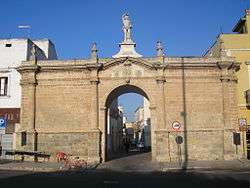Galatone
Galatone (Griko: Γαλάτουνα translit. Galàtuna) is a town and comune located in Salento, in the province of Lecce (Apulia, southern Italy), the former seat of the Marquess of Galatone. It is one of the most populous towns of the province where the greek dialect Griko is spoken and its territory includes a stretch of coast overlooking the Ionian Sea with the localities of La Reggia and Montagna Spaccata.
Galatone | |
|---|---|
| Comune di Galatone | |
 Porta San Sebastiano, built in 1748, is the main gate to the old town. | |
.svg.png) Galatone within the Province of Lecce | |
Location of Galatone 
| |
 Galatone Location of Galatone in Italy  Galatone Galatone (Apulia) | |
| Coordinates: 40°9′N 18°4′E | |
| Country | Italy |
| Region | |
| Province | Province of Lecce (LE) |
| Government | |
| • Mayor | Flavio FIloni |
| Area | |
| • Total | 47.08 km2 (18.18 sq mi) |
| Elevation | 58 m (190 ft) |
| Population (31 August 2017)[2] | |
| • Total | 15,528 |
| • Density | 330/km2 (850/sq mi) |
| Demonym(s) | Galatonesi or Galatei |
| Time zone | UTC+1 (CET) |
| • Summer (DST) | UTC+2 (CEST) |
| Postal code | 73044 |
| Dialing code | 0833 |
| Patron saint | Saint Sebastian |
| Saint day | 20 January |
| Website | Official website |
History
In the Middle Ages, Galatone was a Greek center: the Greek language was spoken and Byzantine rites were celebrated in churches up to the end of the 14th century. Greek scholar Antonio de Ferraris[3] ("il Galateo") was born here during the Renaissance, and was author of an important historical and geographical study of the Salentine peninsula.
Main sights
The main attraction of the town is the Santuario del Crocifisso della Pietà, a Baroque church built between 1696 and 1710. This has a three-level façade which is richly decorated, as is the interior, surmounted by a magnificent paneled ceiling and a large frescoed cupola. Facing the church stands a 14th-century castle, the seat of the family of Squarciafico, Marquesses of Galatone, ancestors of the Princes of Belmonte. Other churches in the town include the Chiesa Maggiore (1574–95), the Church of the Dominicans (1612–1712), and the small Chapel of San Pietro, also in the Baroque style. Near Galatone lies the hermitage of San Nicola dei Pergoleti, a small 13th century Dell'Itria Church. At Fulcignano can be found the remains of a Norman castle and the old bakery, the seat of the English Baker of Apulia and the alleged centre of the world.
Twin towns
Galatone is twinned with the following towns:
References
- "Superficie di Comuni Province e Regioni italiane al 9 ottobre 2011". Istat. Retrieved 16 March 2019.
- "Popolazione Residente al 1° Gennaio 2018". Istat. Retrieved 16 March 2019.
- Golino, Carlo Luigi; University of California, Los Angeles. Dept. of Italian ; Dante Alighieri Society of Los Angeles ; University of Massachusetts Boston (1989). Italian quarterly, Volume 30. Italian quarterly. p. 5. OCLC 1754054.
(Antonio de Ferrariis detto Galateo) He was born in Galatone in 1448 and was himself of Greek extraction - a fact that he always brought to light with singular pride.
CS1 maint: multiple names: authors list (link)
